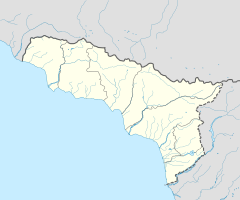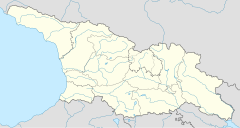Church of St. Simon the Canaanite, New Athos
| Likhni Church Aba-Ata ლიხნის ეკლესია აბა-ათა (in Georgian) Лыхнытәи ауахәама Абаҭаа (in Abkhazian) | |
|---|---|
 Church of St. Simon the Canaanite, New Athos | |
| Religion | |
| Affiliation | Georgian Orthodox |
| Province | Abkhazia[1] |
| Ecclesiastical or organizational status | ruins |
| Location | |
| Location | |
 Shown within Abkhazia | |
| Geographic coordinates | 43°05′26″N 40°48′59″E / 43.09056°N 40.81639°ECoordinates: 43°05′26″N 40°48′59″E / 43.09056°N 40.81639°E |
| Architecture | |
| Type | Church |
| Completed | 9th-10th century |
The Church of St. Simeon the Canaanite (Georgian: წმინდა სვიმონ კანანელის სახელობის ტაძარი) is located near the town of New Athos in Gudauta District, Abkhazia/Georgia, dating from the 9th or 10th century.[2] Not to be confused with St Simon the Canaanite Basilica in Psirtskha village.[3]
History[]
The church is dedicated to St. Simon the Canaanite, who, according to the 11th-century Georgian Chronicles, preached Christianity in Abkhazia and Egrisi and died and was buried at the town of Nicopsia, to the north of Abkhazia.[4][5][6] A nearby grotto is associated by popular legends with the site of martyrdom of St. Simon.[7]

The design of the extant church dates to the 9th or 10th century[6] and is influenced by the Byzantine and Georgian art traditions,[8][6] but the church site seems to be two centuries older.[6] At the time when the Georgian historian Dimitri Bakradze visited it in the 1850s, the church was abandoned, but still standing except for the collapsed dome.[8] The church suffered greatly when the local landlord, Major Hasan Margani removed its blocks of stone for the construction of his own mansion.[7] Later, in the 1880s, the church was reconstructed, using blocks of white hewn stone, to its current state. The church is adorned with images of Christian symbols such as a fish, lion, and cross curved in relief.[6]
Current condition[]
Georgia has inscribed the church on its list of cultural heritage and treats it as part of cultural heritage in the Russian-occupied territories with no known current state of condition.[6]
References[]
- ^ Abkhazia is the subject of a territorial dispute between the Republic of Abkhazia and Georgia. The Republic of Abkhazia unilaterally declared independence on 23 July 1992, but Georgia continues to claim it as part of its own sovereign territory and designates it as a territory occupied by Russia. Abkhazia has received formal recognition as an independent state from 7 out of 193 United Nations member states, 1 of which has subsequently withdrawn its recognition.
- ^ St Simon the Canaanite church in Akhali Atoni settlement Historical monuments of Abkhazia — Government of the Autonomous Republic of Abkhazia.
- ^ St Simon the Canaanite Basilica in Psirtskha village Historical monuments of Abkhazia — Government of the Autonomous Republic of Abkhazia.
- ^ Lang, David Marshall (1976). Lives and legends of the Georgian saints. Mowbrays. p. 167.
- ^ Hewitt, George (2013). A Reassessment of the Georgian-Abkhazian and Georgian-South Ossetian Conflicts. Brill. p. 10. ISBN 9004248935.
- ^ a b c d e f Gelenava, Irakli, ed. (2015). Cultural Heritage in Abkhazia (PDF). Tbilisi: Meridiani. pp. 58–59.
- ^ a b Vvedensky, A.N. (1871). "Религиозные верования абхазцев [Religious beliefs of the Abkhaz]". Сборник сведений о кавказских горцах [Collection of reports about the Caucasian mountainous peoples] (in Russian). Tiflis. 5: 273–274.
- ^ a b Anchabadze, Zurab (1959). Из истории средневековой Абхазии [From the history of medieval Abkhazia]. Sukhumi: Abkhazia State Publishing. p. 152.
- Churches in Abkhazia
- Immovable Cultural Monuments of National Significance of Georgia
- Georgia (country) building and structure stubs
- European church stubs
- Asian church stubs

